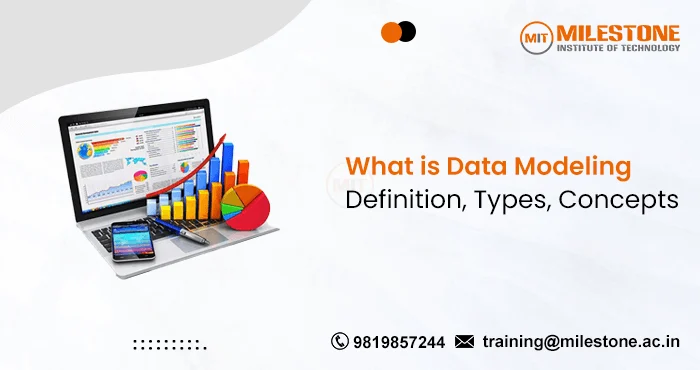In this modern world where data management and analytics plays a crucial role in finding crucial insight and better decision making. Data modeling has become an essential technique which is helping many data analysts and data scientists to organize and manage data in a structured way. It includes visualizing data and its relationships to ensure the correct collection of information and easy access and analysis capability. This complete blog of data modeling will help you understand “
what is data modeling“, its types, concepts, tools, advantages, and many more.
What is Data Modeling? | Definition
Data modeling is the process and techniques of creating a data model by collecting and arranging all the different type of data in a structured way, which will help your business in decision making. As an example, data storage, access, and management follow this model. It ensures accurate, consistent, and effectively retrievable data by means of structural organization of essential data and identifying relationships among them. Designing databases, data warehouses, and information systems depends on data modeling, which also offers a clear framework for data management and usage.
Different Types of Data Modeling
There are various types of data modeling, each are used for different purposes. Some of the essential types are mentioned below:
- Conceptual Data Modeling: This high-level model offers inside a system an overall view of the data and its interactions. Without getting into the technological specifics, it focuses on describing the basic entities and their interactions. Conceptual models help make data requirements and scope understandable.
- Logical Data Modeling: This model adds more clear and specific details about the data structure which helps in enhancing the conceptual model. It actually adds more essential details like data elements, their characteristics, and the connections among entities in a way which is independent of any database technology. Logical data models help to refine data needs and allow preparation for actual implementation.
- Physical Data Modeling: This kind of data modeling turns the logical model into a schema type which is suitable for a certain database system. It addresses specifics such as data types, indexing, constraint construction, and table layout. Physical data models mostly focus on data storage and retrieval optimization.
- Dimensional Data Modeling: This is a data modeling type which is mostly used in data warehousing and business intelligence (BI). By organizing data into a star schema or snowflake structure, it helps to enable effective querying and reporting, which makes it easier to analyze and generate insights.
- Hierarchical Data Modeling: Using a parent-child relationship between elements of data, this model shows data in a tree-like structure. In scenarios where data naturally fits into a hierarchical structure, such as organizational charts or file systems, it is use.
- Network Data Modeling: Network data models include several parent-child connections, unlike hierarchical models, therefore producing a more flexible and connected structure. This kind of representation helps to show complicated relationships in which data elements could have multiple connections.
What is the Process of Data Modeling
There are basic steps which are carried out in the process of data modeling which includes:
- Requirement Gathering: Collect and analyze the requirements from stakeholders to understand what data needs to be captured and how it will be used. This step involves interviewing users, reviewing business processes, and identifying key data elements.
- Conceptual Design: Develop a high-level conceptual model that outlines the main entities and their relationships. This model focuses on capturing the essential data requirements without delving into technical details.
- Logical Design: Create a detailed logical model that specifies the attributes, data types, and relationships between entities. This model refines the conceptual design and prepares it for physical implementation.
- Physical Design: Convert the logical model into an implementable physical schema in a database. This involves defining tables, indexes, constraints, and other technical details specific to the database technology.
- Implementation: Build the database or data warehouse according to the physical design. This step includes creating the database schema, populating it with data, and setting up any necessary data integrity constraints.
- Testing and Validation: Verify that the data model meets the requirements and performs as expected. This step involves testing the data model with real data, checking for inconsistencies, and ensuring that it supports the intended queries and reports.
- Maintenance and Updates: Regularly review and update the data model to accommodate changes in business requirements, data sources, or technology. This ensures that the data model remains relevant and effective over time.
Benefits of Data Modeling
This technique offers several advantages that enhance
data management and analysis:
- Improved Data Quality: By defining clear data structures and relationships, data modeling helps in maintaining data accuracy and consistency. It provides organized data storage and helps to eliminate duplicate data.
- Enhanced Data Understanding: Data models provide a visual representation of data and its relationships, making it easier for stakeholders to understand how data is organized and how it can be accessed.
- Efficient Database Design: Modeling helps in designing databases that are optimized for performance and scalability. It enables management, data retrieval, and efficient storage.
- Better Communication: A well-defined data model serves as a common reference for all stakeholders, including business users, developers, and analysts. It facilitates communication and alignment between different teams.
- Facilitated Data Integration: Data modeling supports the integration of data from multiple sources by providing a consistent framework for data representation. This helps in creating a unified view of data across systems.
- Effective Decision-Making: Data modeling helps to provide more accurate and rapid analysis by means of orderly arranged data. This supports better decision-making based on reliable and accessible information.
Data Modeling Techniques
Modeling of data uses several techniques to create effective and efficient data structures:
- Entity-Relationship Diagram (ERD): ERDs visually show entities, their characteristics, and the relationships among them. They are majorly use in logical and conceptual modeling.
- Normalization: This technique involves organizing data into tables to reduce redundancy and improve data integrity. Normalization ensures that stored data is in a logical and efficient manner.
- Denormalization: Some users employ denormalization to improve query performance by adding redundancy in certain situations. It involves combining tables or adding redundant data to reduce the number of joins required for queries.
- Star Schema: Used in dimensional data modeling, the star schema organizes data into fact tables and dimension tables, creating a structure that supports efficient querying and reporting.
- Snowflake Schema: An extension of the star schema, the snowflake schema normalizes dimension tables into multiple related tables. It reduces redundancy but may be more complex to query.
- UML Class Diagrams: Object-oriented systems represent insights and its connections using unified modeling language (UML) class diagrams. They provide a detailed view of classes, attributes, and associations.
What tools are used for data modeling?
Various tools are available to assist with modeling, each offering different features and capabilities. Some popular data modeling tools include:
- IBM InfoSphere Data Architect: A complete tool including metadata management, data integration, and data modeling.
- Microsoft Visio: Widely used for creating diagrams, including data models, with various templates and shapes.
- Oracle SQL Developer Data Modeler: A powerful tool for designing and managing data models with support for various database platforms.
- ER/Studio: This tool providing advanced features for data model construction, management, and documentation.
- Toad Data Modeler: Provides capabilities for designing, visualizing, and managing data models across different database platforms.
- Lucidchart: An online diagramming tool that supports modeling and collaboration with real-time updates.
- PowerDesigner: A data modeling tool that integrates with various data management processes, including data governance and enterprise architecture.
Where to learn Data Modeling and Data Science?
If you’re looking to gain expertise in these crucial skills, the Milestone Institute of Technology offers comprehensive courses of
data science and data analytics that cover various aspects of models, from fundamental concepts to advanced techniques. The institution gives you actual experience and hands-on instruction, thereby providing you with the tools required to succeed in data management and analysis. Enroll in their advance courses to develop a strong foundation and advance your career in this crucial field.
Frequently Asked Questions
What skills are required for effective data modeling?
Effective modeling requires a combination of technical and analytical skills. Essential skills include expertise of tools, knowledge of database design concepts, and understanding of data structures and interactions. Strong analytical abilities are also important for interpreting business requirements and translating them into data models. Additionally, familiarity with concepts like normalization, data integrity, and different designing techniques is essential.
How can data modeling improve data management and analytics?
It offers a disciplined framework for data access and organization, hence improving data management and analytics. It helps in creating clear, accurate representations of data relationships, which facilitates data integration, consistency, and quality. By using well-defined models, organizations can improve the efficiency of data retrieval, enhance the accuracy of analyses, and ensure that data supports business decision-making effectively.
What are some of the most typical challenges in data modeling, and how are these challenges resolved?
Common challenges in this include handling complex data relationships, ensuring data consistency across systems, and keeping models up-to-date with evolving business requirements. We can address these challenges by using standardized modeling techniques, maintaining clear documentation, and regularly reviewing and updating data models ourselves. Additionally, involving stakeholders in the modeling process can help ensure that the models accurately reflect business needs and requirements.




